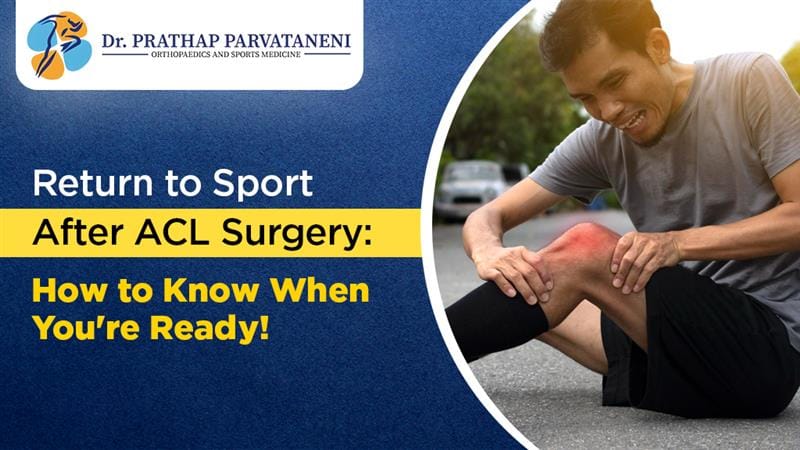
Introduction
Anterior cruciate ligament (ACL) injuries are common, especially among athletes participating in high-impact sports like soccer, basketball, and skiing. For those undergoing ACL surgery, a key question often arises: When is it safe to return to sports? The decision to resume athletic activities post-surgery requires careful consideration of physical readiness, mental preparedness, and clearance from medical professionals. Orthopedic doctors and physical therapists emphasize that a premature return to sports can lead to re-injury, further delaying recovery.
In this blog, we’ll discuss the criteria for safely returning to sports after ACL surgery, including strength and stability assessments, mental readiness, and the final orthopedic evaluation.
Understanding ACL Surgery Recovery
Recovery after ACL reconstruction surgery is a gradual process that can span six months to a year or longer, depending on the individual’s healing and rehabilitation progress. Research shows that athletes who rush back into sports without completing a proper recovery process are at a higher risk of re-injury (Grindem et al., 2016). Therefore, it’s essential to have a structured rehabilitation plan, incorporating both physical and mental aspects to ensure a safe return to sport.
Key Criteria for Returning to Sport After ACL Surgery
1. Strength and Stability Assessments
One of the primary physical markers for determining return readiness is the restoration of strength and stability in the operated leg.
Strength Assessments:
- Quadriceps and Hamstring Strength: According to Buckthorpe and Della Villa (2019), the strength of the quadriceps and hamstrings should reach at least 90% of the uninjured leg to ensure sufficient knee stability. This is measured through isokinetic tests.
- Single-Leg Squats and Jumps: These exercises assess balance and muscle strength. Successful single-leg squats and jumps without pain or instability are positive indicators of knee readiness.
Stability Tests:
- Functional Movement Screening: A functional movement screen involves assessing different movements, like lunges and squats, to identify any compensatory movements or imbalances.
- Hop Tests: Single-leg hop tests are used to assess balance, power, and coordination. A patient should be able to jump at least 90% of the distance achieved on the uninjured leg without discomfort or instability.
2. Balance and Proprioception
Proprioception, or the body’s sense of position, is often affected by an ACL injury. Studies have shown that poor proprioception can increase the risk of re-injury (Ardern et al., 2011). Exercises like balance boards and single-leg stands on uneven surfaces can help restore proprioceptive function.
3. Psychological Readiness
The mental aspect of returning to sports is just as important as physical readiness. Fear of re-injury is a common psychological barrier among athletes, which can hinder performance and increase the risk of further injury.
Assessing Mental Readiness:
- Psychological Questionnaires: Tools like the ACL-Return to Sport after Injury (ACL-RSI) scale help gauge an athlete’s confidence in their knee function. Studies indicate that athletes with a high score on the ACL-RSI are more likely to return to sport successfully and without fear of re-injury (Webster et al., 2018).
- Mental Training and Visualization: Mental conditioning and visualization techniques, guided by a sports psychologist, can boost confidence and readiness for sport.
4. Orthopedic Clearance
The final step in the return-to-sport protocol involves a thorough evaluation by an orthopedic specialist. This assessment includes:
- Knee Joint Examination: Ensures there is no swelling, pain, or instability in the knee.
- Functional Movement Tests: These tests assess range of motion and joint stability under the supervision of a specialist.
- Strength and Agility Tests: To verify that the knee can withstand the intensity of the athlete’s specific sport.
Steps to Ensure Safe Return to Sport
1. Gradual Return-to-Sport Protocol
Returning to sports after ACL surgery is a gradual process. A structured protocol should include:
- Low-Impact Drills: Begin with controlled movements like light jogging and side-to-side agility drills.
- Sport-Specific Drills: Move on to sport-specific movements that mimic the demands of the activity, like dribbling drills for basketball players or agility ladder drills for soccer.
- Full-Intensity Practice: The final stage involves full practice sessions, gradually increasing in intensity to prepare for competition-level exertion.
2. Monitor for Warning Signs
Athletes should be vigilant for signs of potential issues, such as pain, swelling, or instability, which can indicate that the knee isn’t ready for the activity level.
Conclusion
Returning to sport after ACL surgery requires careful consideration of multiple factors, from physical readiness and mental preparedness to clearance from an orthopedic specialist. By following these guidelines and taking a gradual approach, athletes can reduce the risk of re-injury and confidently resume their sports activities.
References
- Ardern, C. L., Webster, K. E., Taylor, N. F., & Feller, J. A. (2011). Return to sport following anterior cruciate ligament reconstruction surgery: A systematic review and meta-analysis of the state of play. British Journal of Sports Medicine, 45(7), 596-606. https://doi.org/10.1136/bjsm.2010.076364
- Buckthorpe, M., & Della Villa, F. (2019). Optimising the late-stage rehabilitation and return-to-sport training and testing process after ACL reconstruction. Sports Medicine, 49(7), 1043-1058. https://doi.org/10.1007/s40279-019-01093-x
- Grindem, H., Granan, L. P., Risberg, M. A., Jensen, J., & Eitzen, I. (2016). How does a combined preoperative and postoperative rehabilitation program influence the outcome of ACL reconstruction 2 years after surgery? British Journal of Sports Medicine, 49(14), 1045-1050. https://doi.org/10.1136/bjsports-2014-093891
- Webster, K. E., & Feller, J. A. (2018). Development and validation of a short version of the ACL-RSI (Anterior Cruciate Ligament-Return to Sport after Injury) scale. Orthopaedic Journal of Sports Medicine, 6(7), 2325967118776735. https://doi.org/10.1177/2325967118776735
